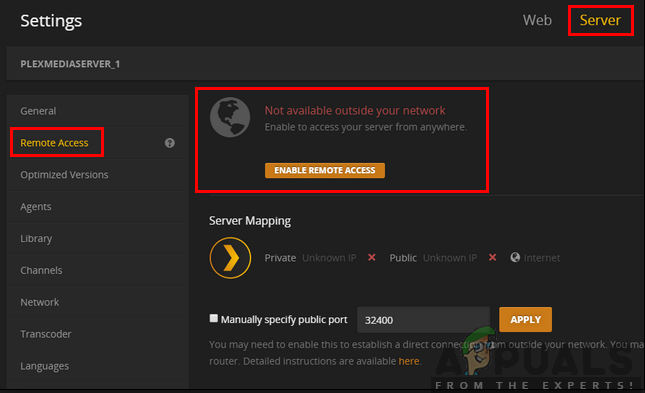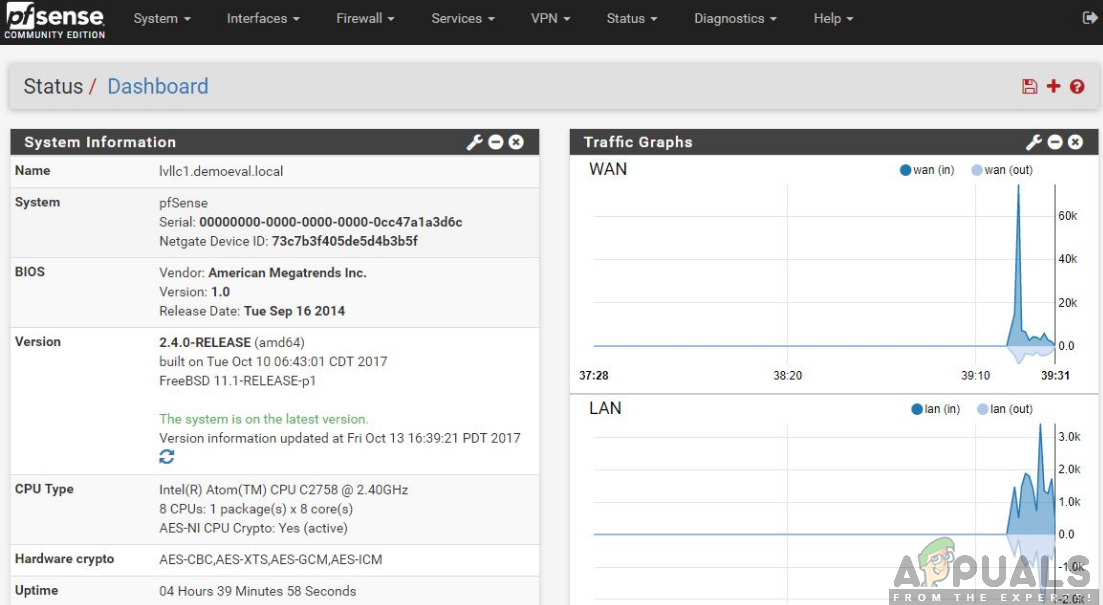Even though the application is great, it is somewhat complex with a lot of parameters to look out for. This is the reason why several people experience issues where they cannot access Plex or get the error message ‘Plex not available outside your network’. This is a very common issue so there is nothing to worry about. In this solution, we will go through all the causes as to why this issue occurs and what you can do to solve the error. The solutions are listed according to the increasing order of complexity and usefulness. Make sure you start with the first one and work your way down.
What causes Plex Remote Access not to Work?
We analyzed several different user cases and analyzed their situation. According to the data we gathered and the reports we got, we compiled together a list of causes which might be responsible for the issue:
Solution 1: Updating to the Latest Version
There are many instances where several bugs are induced into the Plex application which causes it not to work as expected. Software all around us get updates every once in a while and sometimes these updates are not compatible with Plex. Hence its engineers roll out an update targeting this issue solely. If you have an outdated version of Plex Media Server, it is recommended that you update it as soon as possible without any delays. This is very important especially if you are using Plex as a service. Normally, Plex’s web application updates itself over time as you use it. The case is different in case of Ubuntu or other platforms where Plex is running. Below is the method on how to update Plex on an Ubuntu machine. You can easily google other methods for updating if you have it running on another platform. Note: In case of Windows desktop application, you can download the installation file to an accessible location.
Solution 2: Power cycling for Glitch Resolution
Another interesting scenario which occurs quite frequently is where the server goes into an error/glitched state. This usually occurs because Plex is a heavy application with numerous parameters going on simultaneously. If any one of these gets into an error state or load a bad configuration, it might be unusable. There are also network related issues which might prevent you from accessing your Plex server from other devices. Now there are two ways we go about this; either you can power cycle your server machine and the target machine or you can wait the issue out for the network to return to its normal state. For power cycling, follow the steps below:
Solution 3: Fixing Slow Internet Connection
We came across the issue where the media streamed through Plex Media Server seemed to buffer a lot and caused frustration to users. This scenario usually occurs when your internet connection is not sound which forces the server to use less bandwidth in order to provide access to the media. The same scenario also applies to the requesting computer; if you do not have a stable internet connection, you will not be able to request and stream media efficiently. First, you should check the number of devices running on your network (both the server and requesting computer). If they are large in number (+6), you might experience a bottleneck condition. Furthermore, you should also check the overall bandwidth of your connection. It should have decent numbers in order to completely eradicate the buffering issue. You should also consider power cycling your router using the method as in the last solution.
Solution 4: Disabling Advanced Firewalls
Like mentioned before in the causes, advanced firewalls are notorious for blocking connection streams which are sent by Plex media server and are necessary in order for it to work properly. These advanced firewalls include pfsense or similar products. Now there are two ways to bypass this issue; either you can disable your firewall and then try accessing the server or you can make sure that the following IP addresses are not being blocked: You can open the settings of your firewall and check each of these IP addresses against the ones which are being screened. If you find any, whitelist them and after restarting Plex and your computer, check if the issue is resolved.
Solution 5: Checking the Automatic Configuration
There are two ways through which you can configure the Plex server; either you can use the ‘automatic’ configuration method where after enabling few options, Plex configures everything itself or you can manually set all the values and parameters. Since the manual configuration is a little tedious, we will go through the automatic configuration first. Your router should have uPnP or NAT-PMP auto-configured. These settings allow Plex to automatically configure a forwarded port on the router without you having to partake any additional steps. Not all routers have this so follow the method below to check whether it is enabled or not.
Solution 6: Manually Forwarding Port
If the port isn’t being forwarded automatically, we have no option other than manually forwarding the port which Plex will use. Usually, the need for manual port forwarding arises when uPnP or NAT-PMP is not enabled on your router. This method is quite straightforward and isn’t as intimidating as it seems. Make sure that you make a backup of all your configurations just in case or note them down before changing anything in case you need to change later on. First things first, you should make sure that your server’s Local IP Address is Static. When we forward a port, we need to know where we want to forward it. In our scenario, we need to know the local IP address of the computer which is running the Plex Media Server. There are two general approaches to this:
Assign a Static IP to the computer
In this case, we will be manually assigning the network information rather than letting it be automatically configured. Here is the method to set a static IP on your computer:
Reserving IP in Router
If you prefer to make changes in the router instead of the computer, you can manually reserve an IP in your router. This means that the IP will stay static and there will be no shuffling. Follow the method below to reserve an IP address: Note: Make sure that you are aware of the fact that the Wi-Fi card and Ethernet port have several different MAC addresses so choose the one which you think is primary.
Forwarding Port in Router
Now that we have made sure that the IP is static, we can move on to port forwarding. Here is the list of variables which are needed to forward the port manually in the router: You need to map the WAN/External Port (TCP) which you have chosen so that it points to LAN/Internal Port 32400 (TCP) for the server’s local IP address. Now that you know all the information, you can consult your router or our other articles to forward the port properly.
Setting Plex Media Server to Utilize the Port
Now that we are forwarding the port, we will configure our Plex Media Server to utilize it. To do that, follow the steps below: Settings > Server > General Settings > Server > Remote Access Now you can test and check whether the server is accessible without any issues.
Solution 7: Manually Port Forwarding Multiple Servers
The above scenario is perfect and complete if you are only using a single Plex server. However, if you are using multiple servers, the outline will still be the same but some amendments will need to be done. You have to perform the following steps:
You need to choose unique different port numbers for each of your servers.
Remember that you need to use different external port/WAN for each server connection which you are establishing. For example, you can use the ports 32405, 32404, etc.
You need to forward the external port number to internal port number/LAN 32400 for the local IP of the corresponding computer which is hosting the Plex Media Server.
Let’s take an example here. Suppose you have two computers from which you are hosting Plex Media Servers. Their internal IPs are the following: In this situation, you will configure the forwarding mechanism as:
Solution 8: Enabling Bridge Mode (For Double-NAT Scenarios)
NAT is usually used for sharing an internet connection with more than one computers. It is used in small and large scale alike. If you are manually forwarding port, you might have a conflict of Double-NAT, for example, you have a router plugged into a modem provided to you by your service provider. Here both, the modem and the router are providing NAT services. Double-NAT basically interferes with the server which is trying to create automatic connections. This might also occur if the public IP assigned to you by your ISP is itself also using NAT services.
Detecting a Double-NAT
Before we start fixing the double-NAT condition, you need to make sure that you even have a Double-NAT. Here, you will need to first look in the settings in your router to which your computer/server is connected to. Note: Do note that you will be looking at your router’s settings, not your ISPs modem settings. If both the IPs don’t match, you don’t have Double-NAT. If they match, you are probably experiencing it.
Fixing Double-NAT
Fixing a Double-NAT scenario is very easy and straightforward. You will be using the bridge mode in one of the devices so instead of two, only one device is providing the NAT services. There is also the option of setting up a port forward on all the NAT devices so the network requests are properly tailored and sent through. The best and easy solution here is to call your ISP and ask them to set up the Bridge mode for you. You can attempt at doing this by yourself using endless tutorials online but asking the ISP to do it will take less time with no errors. Note: If you are set in using a Carrier Grade NAT, you might need to ask your ISP to purchase a static IP on your behalf so you can use it.
Fix: The Remote Connection was not Made Because the Name of the Remote Access…[FIX] ‘There Was an Unexpected Error Loading this Library’ in Plex[FIX] ‘Error code: S1001 (Network)’ in Plex Media PlayerHow to Control Plex with Alexa









